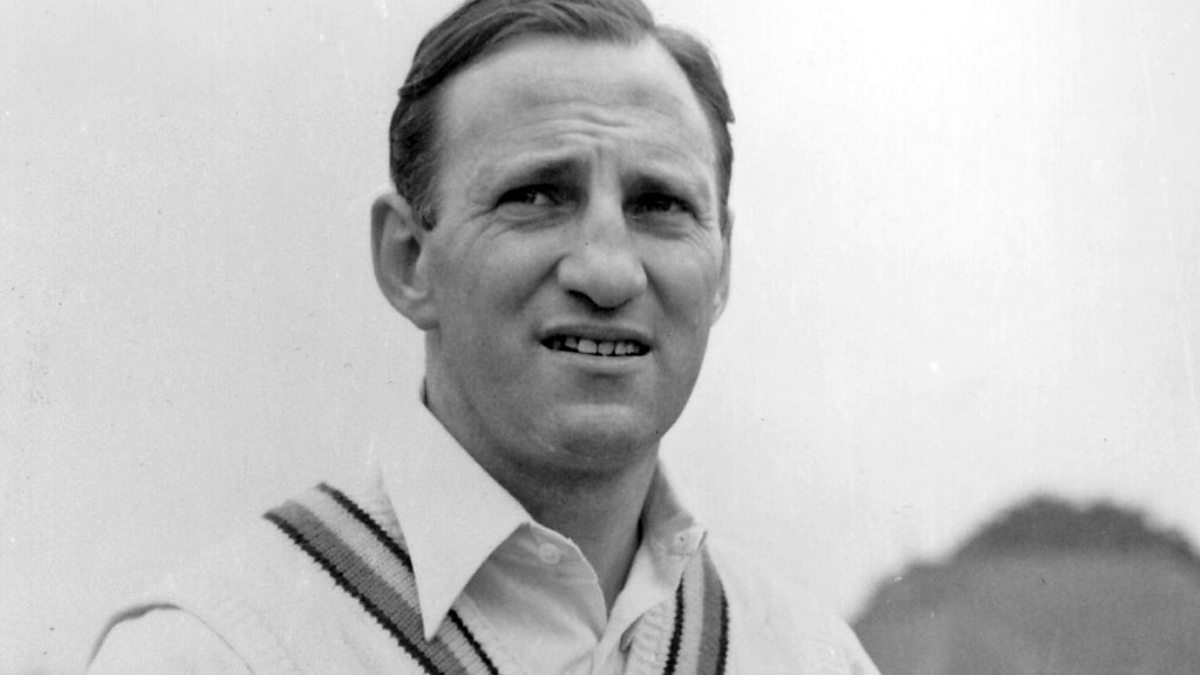When Len Hutton carved boundaries through post-War ashes drifting over Yorkshire hills, England discovered disciplined assurances their uncertain realm then craved – a formative stalwart batting with grit befitting industrial Monica.
Hutton indeed embodied the country’s resilience – combining focus honed conquering textile machinery rhythms with sheer bloodymindedness to dismantle attacks rendered helpless on good length offerings routinely dismissed.
Figures stacked record run piles weathering storms in both home climes and far-flung lands of the fading Empire. But deeper significance accompanied the statistics – his sustained excellence spurring euphoria within ration-wearied spirits during reconstruction’s difficult dawn.
Later as captain, Hutton shepherded continuity bridging eras either side of tumults while lending sage counsel to heir apparents seeking direction.
Article Highlights
Hide- Sir Leonard Hutton was born on June 23, 1916, in the West Riding of Yorkshire and grew up in Fulneck, near Pudsey.
- Hutton showed early talent in cricket and received coaching from his father, which helped him develop a profound understanding of the game's technicalities and strategies.
- He made his debut for Yorkshire in 1934 and for England in 1937, and went on to achieve numerous milestones, including scoring a record-breaking 364 runs against Australia in 1938 and becoming the first professional cricketer to captain England.
- Hutton's playing style was known for his patience, solid defensive technique, strong back foot game, exceptional footwork against spinners, and mastery of leaving deliveries outside the off-stump.
In many ways Len Hutton catalogued changing tides – from modest war-era origins to embracing modern celebrity before deferring attention for selfless coaching duties.
Behind the extraordinary batting figures lies understated profundity – a icon demonstrating both dedicated work ethic and adaptation finding renewed purposes when proving one’s worth stayed paramount above self-indulgent comforts.
Early Life and Upbringing
Born on June 23, 1916, in the West Riding of Yorkshire, Sir Leonard Hutton was raised in a milieu where cricket was a pervasive and cherished part of the local culture.
His early life was steeped in the traditions of the game, which was not merely a sport but a symbol of self-discipline and collective endeavor in the face of adversity.
Sir Richard Hadlee
When Richard Hadlee sprung his lithe frame into gliding action, New Zealand discovered potent ... Read More
Hutton’s upbringing in Fulneck, near Pudsey, provided the fertile ground for his cricketing prowess to flourish. Under the guidance of his father, who was also an avid cricketer, Hutton honed his skills and developed a profound understanding of the game’s technicalities and strategies.
Hutton’s formative years were marked by the prevailing ethos of resilience and the striving for excellence, which were the cornerstones of his later success.
The era into which he was born witnessed the aftermath of World War I, and the societal impetus was towards rebuilding and progress. Cricket, in this context, was an avenue for the expression of these values.
Hutton’s early life narrative is thus emblematic of the broader cultural emancipation of his time, where the pursuit of sporting greatness was intertwined with the quest for personal and communal liberation.
Sir Leonard Hutton: Rise to Cricket Stardom
Leonard Hutton’s ascent to cricketing greatness commenced with his debut for Yorkshire in 1934, a milestone that marked the beginning of an illustrious career distinguished by technical mastery and strategic acumen.
His early appearances at the crease were a harbinger of the legendary status he would later achieve, showcasing an innate capacity for concentration and a technique that would become the cornerstone of England’s batting line-up.
Hutton’s analytical approach to the game, coupled with his ability to adapt to varied pitch conditions and bowling attacks, rapidly elevated his status among contemporaries and cricket pundits alike.
Quantitative analysis of Hutton’s performances during this formative period reveals a steady trajectory of improvement and consistency.
His penchant for accumulating substantial innings is evidenced by his rising batting averages and frequency of match-defining contributions. Such statistical evidence underscores the objective assessment of Hutton’s growing influence on the sport.
In the realm of cricket, where the quest for liberation from the shackles of mediocrity is relentless, Hutton’s rise to stardom was a testament to meritocracy and the pursuit of excellence.
His career progression served as an exemplar for aspiring cricketers, advocating that through dedication and refinement of skill, one could indeed scale the heights of cricketing prowess.
Record-Breaking Performances
Amidst the annals of cricket history, Sir Leonard Hutton’s record-breaking innings of 364 runs against Australia in 1938 stands as a monumental testament to his extraordinary batting prowess and indomitable spirit. Delving into the details of this historic event reveals the magnitude of Hutton’s achievement.
His 364-run knock, amassed over 13 hours and 17 minutes at The Oval, not only shattered Don Bradman’s previous record of 334 but also set a new benchmark for individual scores in Test cricket—a record that would stand for nearly two decades.
Analyzing the context of Hutton’s innings underscores its significance. It transpired during the Ashes, a series steeped in prestige and competitive intensity.
Hutton, only 22 at the time, demonstrated impeccable technique and stamina, facing 847 balls and guiding England to a commanding first-innings total of 903-7 declared.
This performance was instrumental in England reclaiming the Ashes with an innings victory, showcasing Hutton’s capacity to influence the outcome of a series fundamentally.
Moreover, Hutton’s concentration and mental fortitude throughout the innings set him apart from his contemporaries and predecessors.
His record epitomized a liberation from the constraints of time and fatigue, embodying the essence of sporting excellence and the relentless pursuit of greatness.
Sir Leonard Hutton: Post-War Impact and Captaincy
Emerging from the shadows of World War II, Sir Leonard Hutton’s influence on cricket extended well beyond his playing prowess, as he assumed the mantle of England’s captain and became a central figure in the sport’s post-war resurgence.
His strategic acumen and innovative leadership marked a period of transformation for the English cricket team. Under his captaincy, Hutton instilled a sense of discipline and tactical sophistication that had been absent in the pre-war years.
Hutton’s tenure as captain was not just symbolic; it was statistically significant as well. His captaincy record speaks volumes about his impact on the game and the national team’s performance. The following table provides a snapshot of his statistical achievements during his captaincy:
| Aspect | Statistic | Impact on Team |
|---|---|---|
| Matches as Captain | 23 | Instilled a new strategic approach to post-war cricket |
| Wins | 11 | Led England to notable victories, solidifying his legacy |
| Losses | 5 | Demonstrated resilience in rebuilding the team’s strength |
Hutton’s leadership transcended mere numbers; it signified the dawn of a liberated, strategic, and competitive English cricket post-World War II. His legacy as a captain is a testament to his visionary approach to the game and his unwavering commitment to excellence.
Legacy and Statistical Review
Reflecting on Sir Leonard Hutton’s captaincy, his enduring legacy in the realm of cricket becomes evident through a detailed examination of his career statistics and contributions to the game.
His meticulous approach to batting and leadership on the field revolutionized the way cricket was played and perceived. Hutton’s statistical records offer a testament to his skill and dedication, underlining why he is considered one of the game’s greats.
To add depth and engage the audience further, consider the following key points:
- Hutton held the record for the highest individual Test score (364) for nearly 20 years.
- He was the first professional cricketer to captain England in over two decades.
- His career Test batting average of 56.67 places him among the elite in cricket history.
- Hutton’s influence extended beyond the field, advocating for the abolition of the distinction between amateurs and professionals.
- Post-retirement, he contributed to the game as a selector and manager, shaping future generations.
Sir Leonard Hutton’s legacy, punctuated by his statistical prowess, is a narrative of excellence and innovation. His contributions transcended the statistics, advocating for a more egalitarian and meritocratic approach to the sport, thus liberating it from the fetters of outdated class distinctions.
Final Thought
In conclusion, Sir Leonard Hutton’s contributions to cricket are monumental, characterized by record-breaking performances and astute captaincy.
His exemplary career, marked by technical proficiency and resilience, has left an indelible mark on the sport. Statistical analysis underscores his dominance and the high esteem in which he is held within the cricketing fraternity.
Hutton’s legacy endures, exemplifying the pinnacle of sporting excellence and serving as an inspiration for future generations of cricketers.

















